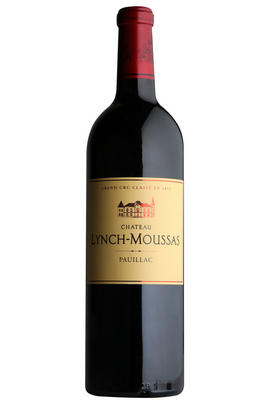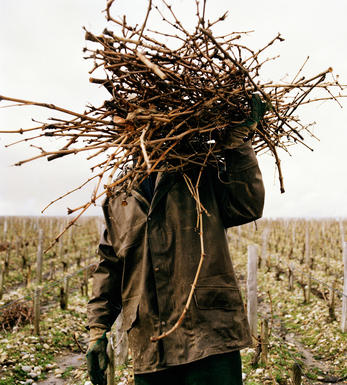
2020 Château Lynch-Moussas, Pauillac, Bordeaux

Critics reviews
Drink from 2025 to 2045
Neal Martin, Vinous (May 2021)
Drink from 2030 to 2050
Antonio Galloni, Vinous (June 2021)
James Suckling, jamessuckling.com (April 2021)
Jeb Dunnuck, jebdunnuck.com (May 2021)
About this WINE

Chateau Lynch-Moussas
Château Lynch-Moussas is a 5ème Cru Classé estate located in the south-west of the Pauillac wine appellation. Lynch-Moussas has been thoroughly renovated in the last 30 years and is now producing high quality claret. Lynch-Moussas's impressive château dates back to 1850, but the key date in Lynch-Moussas` history was 1969 when it was bought by Emile Castéja, owner of Château Batailley and négociant firm Borie-Manoux. Extensive replanting and much-needed modernisation in the cellars have transformed the quality of the wine.
Lynch-Moussas is a typically a blend is Cabernet Sauvignon based and the wine is aged in 60% new oak barrels for between 12 and 18 months. The wines are rich in black fruits and display prominent vanilla notes. For a Pauillac, Lynch-Moussas contains a relatively high proportion of Merlot and is consequently a softer, silkier and lusher wine than many of its neighbours.

Pauillac
Pauillac is the aristocrat of the Médoc boasting boasting 75 percent of the region’s First Growths and with Grand Cru Classés representing 84 percent of Pauillac's production.
For a small town, surrounded by so many familiar and regal names, Pauillac imparts a slightly seedy impression. There are no grand hotels or restaurants – with the honourable exception of the establishments owned by Jean-Michel Cazes – rather a small port and yacht harbour, and a dominant petrochemical plant.
Yet outside the town, , there is arguably the greatest concentration of fabulous vineyards throughout all Bordeaux, including three of the five First Growths. Bordering St Estèphe to the north and St Julien to the south, Pauillac has fine, deep gravel soils with important iron and marl deposits, and a subtle, softly-rolling landscape, cut by a series of small streams running into the Gironde. The vineyards are located on two gravel-rich plateaux, one to the northwest of the town of Pauillac and the other to the south, with the vines reaching a greater depth than anywhere else in the Médoc.
Pauillac's first growths each have their own unique characteristics; Lafite Rothschild, tucked in the northern part of Pauillac on the St Estèphe border, produces Pauillac's most aromatically complex and subtly-flavoured wine. Mouton Rothschild's vineyards lie on a well-drained gravel ridge and - with its high percentage of Cabernet Sauvignon - can produce (in its best years) Pauillac's most decadently rich, fleshy and exotic wine.
Latour, arguably Bordeaux's most consistent First Growth, is located in southern Pauillac next to St Julien. Its soil is gravel-rich with superb drainage, and Latour's vines penetrate as far as five metres into the soil. It produces perhaps the most long-lived wines of the Médoc.
Recommended Châteaux
Ch. Lafite-Rothschild, Ch. Latour, Ch. Mouton-Rothschild, Ch. Pichon-Longueville Baron, Ch. Pichon Longueville Comtesse de Lalande, Ch. Lynch-Bages, Ch. Grand-Puy-Lacoste, Ch, Pontet-Canet, Les Forts de Latour, Ch. Haut-Batailley, Ch. Batailley, Ch. Haut-Bages Libéral.

Cabernet Sauvignon Blend
Cabernet Sauvignon lends itself particularly well in blends with Merlot. This is actually the archetypal Bordeaux blend, though in different proportions in the sub-regions and sometimes topped up with Cabernet Franc, Malbec, and Petit Verdot.
In the Médoc and Graves the percentage of Cabernet Sauvignon in the blend can range from 95% (Mouton-Rothschild) to as low as 40%. It is particularly suited to the dry, warm, free- draining, gravel-rich soils and is responsible for the redolent cassis characteristics as well as the depth of colour, tannic structure and pronounced acidity of Médoc wines. However 100% Cabernet Sauvignon wines can be slightly hollow-tasting in the middle palate and Merlot with its generous, fleshy fruit flavours acts as a perfect foil by filling in this cavity.
In St-Emilion and Pomerol, the blends are Merlot dominated as Cabernet Sauvignon can struggle to ripen there - when it is included, it adds structure and body to the wine. Sassicaia is the most famous Bordeaux blend in Italy and has spawned many imitations, whereby the blend is now firmly established in the New World and particularly in California and Australia.


Buying options
Add to wishlist
Description
Cabernet Sauvignon 72%, Merlot 28%
This sibling of Batailley has progressed well recently. The 2020 is lush and oaky. Stylistically, it falls between the plushness of some ’20s and the freshness of others. All the elements are there, with sweet oak notes to the fore. It perhaps lacks a little detail but is also a notch above expectations. The finish is good; there is acidity. This is a wine that will give pleasure, if not one to set all the senses alight – but it’s a good price for classified-growth Pauillac.
Drink 2026-2038
wine at a glance
Delivery and quality guarantee